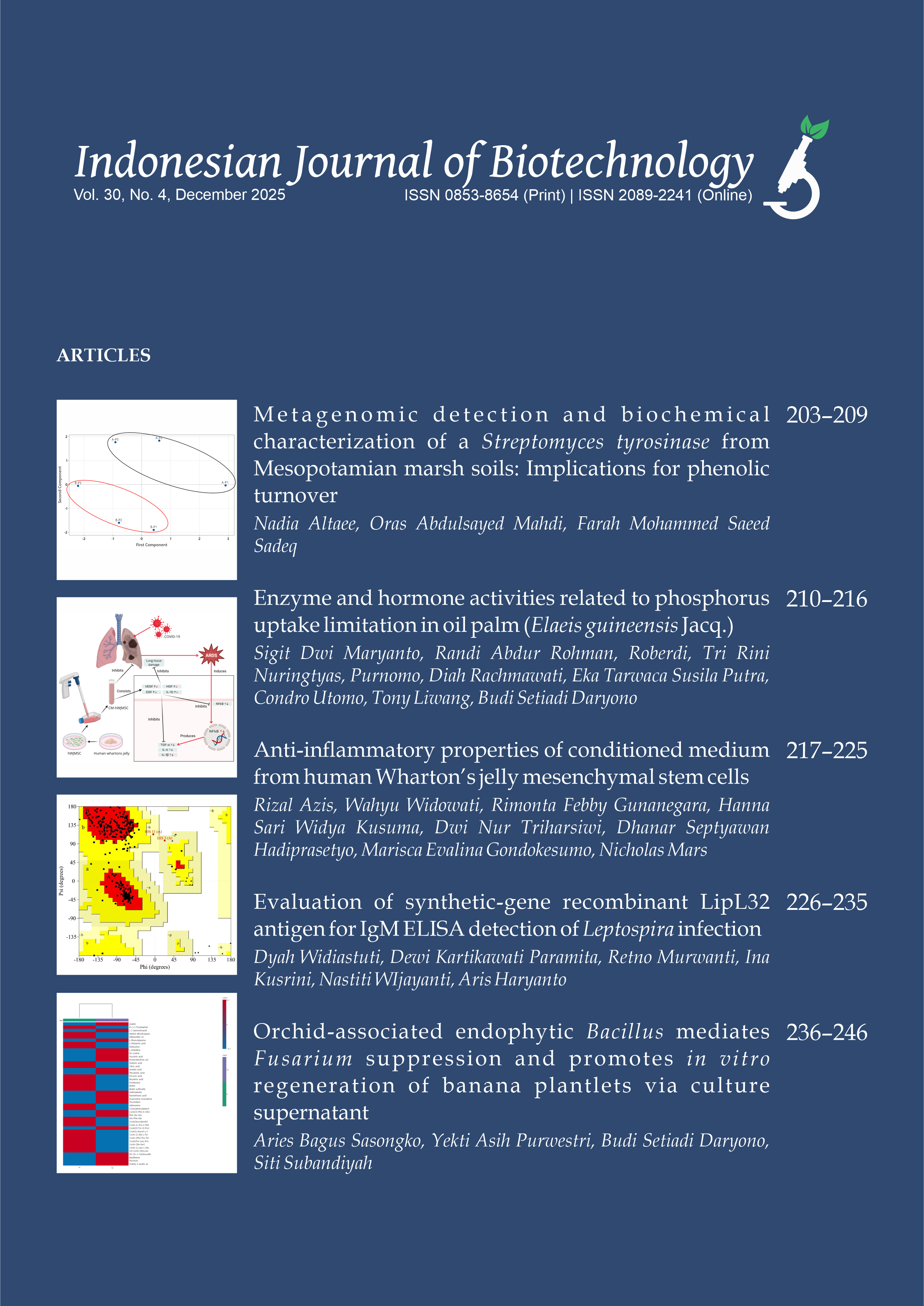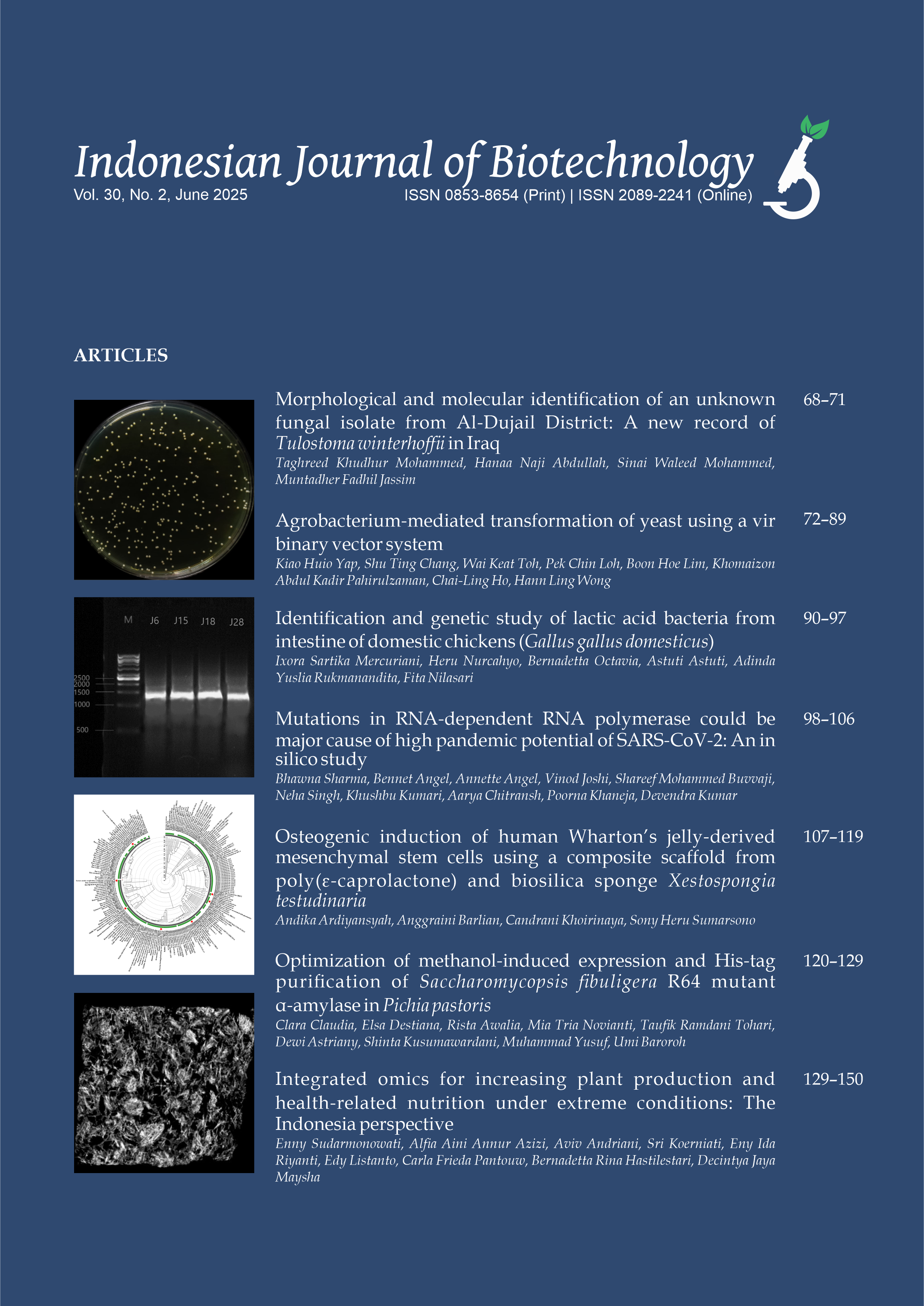Formulation of Medium Viscosity Chitosan-Pectin –MJ Protein Nanoparticles Conjugated with Anti-Ep-CAM and Its Cytotoxicity Against T47D Breast Cancer Cell Lines
Anggun Feranisa(1), Dewa Ayu Arimurni(2), Hilda Ismail(3), Ronny Martien(4), S. Sismindari(5*)
(1) Biotechnology Study Program, Graduate School, Universitas of Gadjah Mada, Yogyakarta, Indonesia Faculty of Dentistry, Islamic Universitas Sultan Agung, Semarang, Central Java, Indonesia
(2) Biotechnology Study Program, Graduate School, Universitas of Gadjah Mada, Yogyakarta, Indonesia
(3) Faculty of Pharmacy, Universitas Gadjah Mada, Yogyakartaa, Indonesia
(4) Faculty of Pharmacy, Universitas Gadjah Mada, Yogyakartaa, Indonesia
(5) Biotechnology Study Program, Graduate School, Universitas of Gadjah Mada, Yogyakarta, Indonesia Faculty of Pharmacy, Universitas Gadjah Mada, Yogyakartaa, Indonesia
(*) Corresponding Author
Abstract
Chitosan nanoparticle could become potential formula to protect protein degradation during therapy,
since chitosan nanoparticles have “proton sponge hypothesis” mechanism on its protection. Chitosan and pectin
is used as basic formula of drug delivery because of its biodegradable and biocompatible properties. Chitosanpectin nanoparticles can be formulated by polyelectrolit complex. EpCAM showed excessive expression in
epithelial cancer cells thus can be used as a therapeutic biomarker. MJ protein, a Ribosome-Inactivating Proteins
(RIPs) isolated from Mirabilis jalapa L had a higher cytotoxicity on malignant cells than normal cells. MJ protein
need to be formulated to protect from proteosome degradation in endosome. The aim of this research was to
develop MJ protein-chitosan-pectin nanoparticles and conjugated with anti EpCAM for breast cancer therapy.
Mj protein was extracted from M.jalapa leaves. RIPs activity was assayed by supercoiled DNA cleavage. MJ
protein were loaded into chitosan nanoparticles using medium viscous chitosan and pectin as cross-linker with
polyelectrolit complex method. Anti EpCAM was conjugated to MJ protein-chitosan-pectin nanoparticles by
carbodiimide reaction and characterized for its entrapment efficiency, morphology by transmission electron
microscope, particles size, and zeta potential. MJ protein nanoparticles conjugated anti EpCAM and without
anti EpCAM were cytotoxicity assayed toward T47D and Vero cell lines. MJ protein was able to cleave the
supercoiled DNA into linear and nicked-circular ones. The nanoparticles optimal concentration of medium
viscous chitosan: MJ protein: pectin was 0.01%: 0.01%: 1% (m/v). A high entrapment efficiency of MJ protein
nanoparticles was 98.97 ± 0.07%. Morphology nanoparticles showed an amorphic structure with 200.00 nm
particles size. The nanoparticles conjugated anti EpCAM showed average particles size 367.67nm, polydispersity
index 0.332, and zeta potential +39.97mV. MJ protein-chitosan-pectin nanoparticles conjugated anti EpCAM
and unconjugated both had higher cytotoxicity with the IC50 57.64 μg/mL and 46.84 μg/mL respectively
against T47D and 99.38 μg/mL and 111.34 μg/mL against Vero cell lines compared to MJ protein with IC50 of
3075.61 μg/mL against T47D and 3286.88 μg/mL against Vero cell lines. Both MJ protein-nanoparticles could
increase the cytotoxicity effects about 50 times compared to the unformulated MJ protein activity, however
had less specificity toward T47D and Vero cell lines.
since chitosan nanoparticles have “proton sponge hypothesis” mechanism on its protection. Chitosan and pectin
is used as basic formula of drug delivery because of its biodegradable and biocompatible properties. Chitosanpectin nanoparticles can be formulated by polyelectrolit complex. EpCAM showed excessive expression in
epithelial cancer cells thus can be used as a therapeutic biomarker. MJ protein, a Ribosome-Inactivating Proteins
(RIPs) isolated from Mirabilis jalapa L had a higher cytotoxicity on malignant cells than normal cells. MJ protein
need to be formulated to protect from proteosome degradation in endosome. The aim of this research was to
develop MJ protein-chitosan-pectin nanoparticles and conjugated with anti EpCAM for breast cancer therapy.
Mj protein was extracted from M.jalapa leaves. RIPs activity was assayed by supercoiled DNA cleavage. MJ
protein were loaded into chitosan nanoparticles using medium viscous chitosan and pectin as cross-linker with
polyelectrolit complex method. Anti EpCAM was conjugated to MJ protein-chitosan-pectin nanoparticles by
carbodiimide reaction and characterized for its entrapment efficiency, morphology by transmission electron
microscope, particles size, and zeta potential. MJ protein nanoparticles conjugated anti EpCAM and without
anti EpCAM were cytotoxicity assayed toward T47D and Vero cell lines. MJ protein was able to cleave the
supercoiled DNA into linear and nicked-circular ones. The nanoparticles optimal concentration of medium
viscous chitosan: MJ protein: pectin was 0.01%: 0.01%: 1% (m/v). A high entrapment efficiency of MJ protein
nanoparticles was 98.97 ± 0.07%. Morphology nanoparticles showed an amorphic structure with 200.00 nm
particles size. The nanoparticles conjugated anti EpCAM showed average particles size 367.67nm, polydispersity
index 0.332, and zeta potential +39.97mV. MJ protein-chitosan-pectin nanoparticles conjugated anti EpCAM
and unconjugated both had higher cytotoxicity with the IC50 57.64 μg/mL and 46.84 μg/mL respectively
against T47D and 99.38 μg/mL and 111.34 μg/mL against Vero cell lines compared to MJ protein with IC50 of
3075.61 μg/mL against T47D and 3286.88 μg/mL against Vero cell lines. Both MJ protein-nanoparticles could
increase the cytotoxicity effects about 50 times compared to the unformulated MJ protein activity, however
had less specificity toward T47D and Vero cell lines.
Keywords
Mirabilis jalapa L.; RIPs; nanoparticle; pectin; chitosan; anti EpCAM
Full Text:
PDFArticle Metrics
Refbacks
- There are currently no refbacks.
Copyright (c) 2016 Anggun Feranisa, Dewa Ayu Arimurni, Hilda Ismail, Ronny Martien, S. Sismindari

This work is licensed under a Creative Commons Attribution-ShareAlike 4.0 International License.









